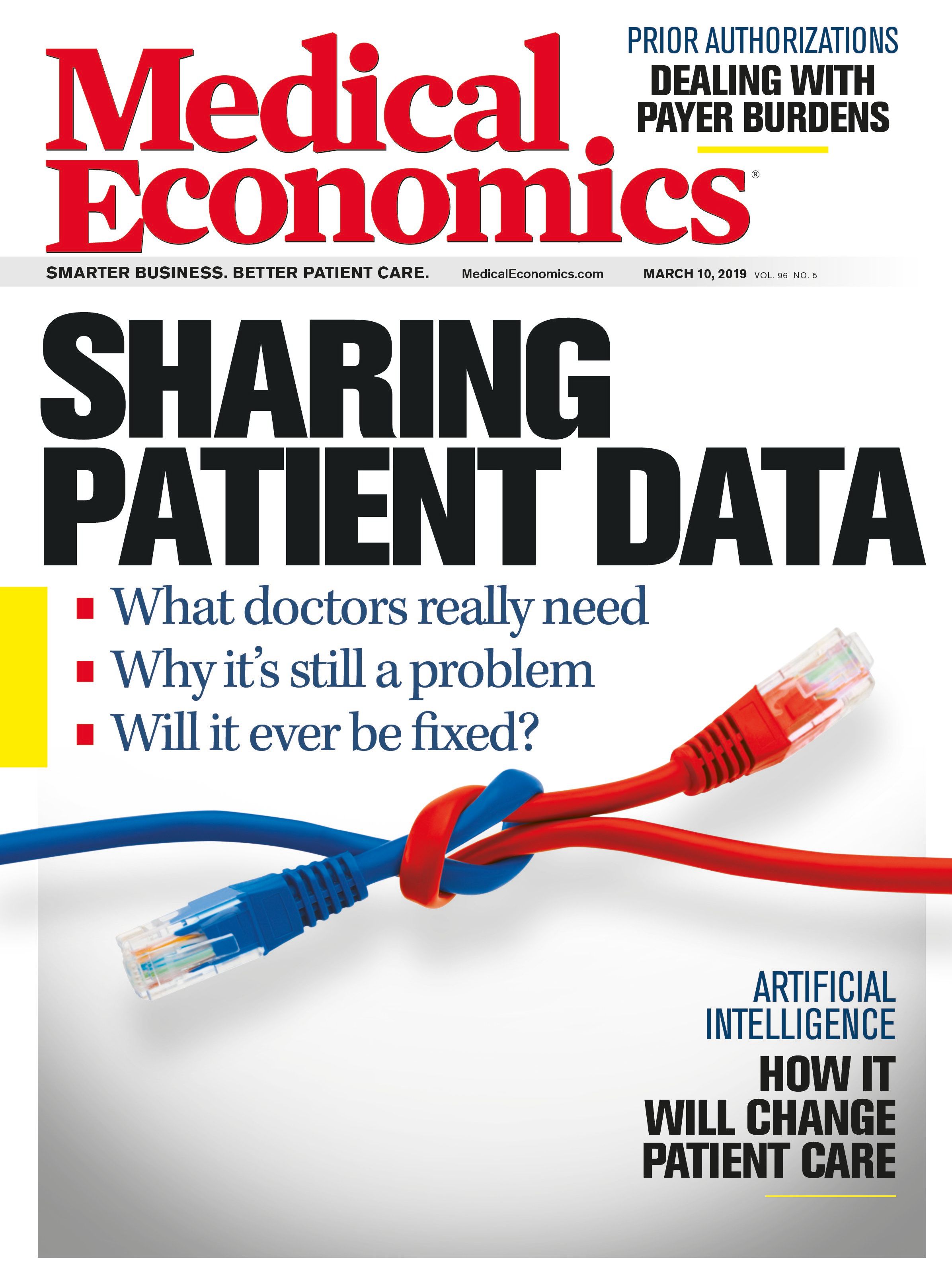
- Revenue Cycle Management
- COVID-19
- Reimbursement
- Diabetes Awareness Month
- Risk Management
- Patient Retention
- Staffing
- Medical Economics® 100th Anniversary
- Coding and documentation
- Business of Endocrinology
- Telehealth
- Physicians Financial News
- Cybersecurity
- Cardiovascular Clinical Consult
- Locum Tenens, brought to you by LocumLife®
- Weight Management
- Business of Women's Health
- Practice Efficiency
- Finance and Wealth
- EHRs
- Remote Patient Monitoring
- Sponsored Webinars
- Medical Technology
- Billing and collections
- Acute Pain Management
- Exclusive Content
- Value-based Care
- Business of Pediatrics
- Concierge Medicine 2.0 by Castle Connolly Private Health Partners
- Practice Growth
- Concierge Medicine
- Business of Cardiology
- Implementing the Topcon Ocular Telehealth Platform
- Malpractice
- Influenza
- Sexual Health
- Chronic Conditions
- Technology
- Legal and Policy
- Money
- Opinion
- Vaccines
- Practice Management
- Patient Relations
- Careers
The impact of prior authorizations
Payer interference is increasing. Here's what to do about it.
©wladimir180/stock.adobe.com

One of the most infuriating challenges for physicians is obtaining prior authorizations for prescriptions and testing. In the eyes of physicians, prior authorizations are nothing more than insurance companies inserting themselves into the care decision-making process, creating problems for both doctors and patients.
Most doctors view prior authorizations as an attack on their autonomy, their years of training, and their ability to care for their patients. Plus, there’s the time wasted and revenue lost due to haggling with payers over approval for drugs and tests. In a recent survey, physicians told Medical Economics that prior authorizations were one of the major problems that were “ruining medicine.”
“Prescriptions are expensive and prior authorizations are an easy way for insurance companies to save money,” says Matthew Mintz, MD, FACP, an internist in Bethesda, Md. “The process is made, in my opinion, purposefully burdensome so that the physician or patient will simply give up, and use a cheaper alternative.”
Prior authorizations surge
According to a December 2017 study from the American Medical Association, 86 percent of physicians report that prior authorizations have increased during the prior five years and 51 percent report that they have increased significantly.
The health insurance industry says prior authorizations are an important tool adopted by health plans and government-sponsored healthcare programs to help ensure patients receive the best care.
“It protects patients, ensuring that the treatment is safe, medically necessary and appropriate,” says Cathryn Donaldson, the director of communications for America’s Health Insurance Plans (AHIP), an industry group. “Health insurance providers have a 360-degree view into how patients use their care and coverage, and we are committed to helping people get better when they’re sick and keeping them healthy when they’re well.”
Just as doctors use scientific evidence to determine the safest, most effective treatments, health insurance providers rely on data and evidence to understand what tools, treatments, and technologies best improve patient health, Donaldson says.
“It takes collaboration between health insurance providers and clinicians and hospitals,” Donaldson says, adding that AHIP agrees that the prior authorization process can be more efficient. That’s why in January 2018, AHIP, in conjunction with the American Medical Association (AMA) and other healthcare organizations, issued a pledge to streamline the prior authorization process.
The bottom line
But many physicians believe that the true motivator of prior authorizations is the bottom line for payers, not necessarily patient care.
Timothy Cordes, MD, a pediatric cardiologist in Indianapolis, Ind., says he has experienced a rise in prior authorization requests over the last couple of years. “They seem to modify their own internal guidelines regarding when certain testing is indicated, and how frequently these tests should be repeated,” he says. “More often, lately, the insurance guidelines don’t match the medical society recommendations or don’t align with common practice.”
Cordes notes that every discussion with an insurance company’s physicians requires spending time to educate the reviewing MD, who might not be familiar with the specialty.
“Wasting physician and nurse time does not reduce healthcare costs,” he says. “All prior authorization calls by doctors or nurses requires time and resources. The insurance company prior authorization requirement and obstacle impedes timely and efficient provision of care. It also usurps the doctors’ decisions and ultimate responsibility for care, but does not compensate for time spent or assume medical-legal responsibility for patient outcomes.”
The fact that practices bear the burden of requesting the prior authorization is what causes so much frustration among providers, says Johnathan Rhodes, JD, a healthcare attorney at Denver-based Fennemore Craig Rhodes.
“Both individual and institutional healthcare providers must hire people just to manage these prior authorizations and shepherd them through the process,” he says. “Keep in mind that many providers, particularly the large institutional providers, may deal with dozens or even hundreds of different health plans, all with different requirements related to prior authorizations. This leads to a very frustrating and cumbersome process.”
Kevin Gebke, MD, a family practitioner at Indiana University Health, says prior authorizations have long been a challenge for providers and their staff because insurance companies have different requirements for formulary inclusion and prior authorization criteria.
“There certainly are times when prior authorizations are reasonable and limit unnecessary testing or reduce costs of medication therapy,” Gebke says. “Unfortunately, we do recognize that many of these hoops are in place to discourage utilization. This, in turn, feeds into the pessimism.”
Impact on patient care
By putting the burden of lowering costs on physicians through increasing numbers of prior authorizations, insurance companies are detracting from patient care, Mintz says.
Most physicians agree, according to the AMA survey. More than 90% said that prior authorizations have a negative affect on patient care, either by delaying care or causing patients to abandon treatment.
More than 60% of physicians said they needed to wait at least one business day to complete prior authorizations, while 30% said they have had to wait three business days or longer.
This time lag creates a massive barrier to patients receiving the care they need, says Matthew Hahn, MD, a family physician in Hancock, Md., and author of Distracted: How Regulations Are Destroying the Practice of Medicine and Preventing True Health-Care Reform.
“The more hoops a doctor or practice has to jump through to obtain care for their patients, the less likely that care will take place,” says “In addition, some meds, tests and referrals are declined in the prior authorization process.”
“The burden created by prior authorizations is extremely taxing to physicians and medical practices, creating minutes to hours of work just to obtain basic care for their patients,” he adds. “This translates into added administrative costs for practices, and incredible distraction from patient care, which is difficult even under optimal circumstances.”
Strategies to help
Gebke says the most effective way physicians can lessen the burden on their practices is to standardize in-office processes for handling prior authorizations.
“Typically, we tend to have a set of standard work for our staff to follow-to prepare prior authorizations for approval or final input from the physician,” Gebke says. “The real challenge is knowing which services will require a prior authorization.”
“We recognize that [prior authorization] is going to be in administrative burden, but if we can approach it as a team so that the providers are not completely overburdened by the task, it makes it seem more manageable,” he adds.
There are also technology tools that can help. Cordes says a strategy physicians can use to help ease the burden is to take advantage of any electronic or automated
processes a payer may have for receiving requests and returning determinations.
“Automated prior authorization processes seem to be increasing in number and some states even require an electronic process with respect to prescription drugs,” he says. “Make sure whoever is accountable for the prior authorization process is familiar with that particular payer’s requirements. There may be certain deadlines, documentation, etc., that vary from payer to payer and providers need to be aware of what those are.”
But electronic systems are not perfect. It’s rare that a physician gets an immediate answer, and will often need to check back to provide more information.
Mintz also likes electronic authorization, and has found it to be his most effective coping strategy. It eliminates the huge pain point of waiting on the telephone, dealing with cumbersome automated phone trees and getting disconnected, Mintz says. That allows staff to focus their efforts on cases that don’t meet the rules for automated approval.
Communication matters
Physicians need to communicate effectively with patients regarding prior authorizations, and it’s often better to address the matter proactively with patients rather than wait until a treatment has been denied.
Hahn explains to his patients, many of whom are often unaware of the prior authorization process, that insurance coverage for some medications, tests, and referrals is difficult to obtain because the insurance company makes it so difficult for the physician and his or her staff.
“There’s not much we can do. This is dictated by the insurance,” he says. “As for medications, we often try to encourage patients to use a medication that doesn’t require prior authorization.”
Once it is understood that a prior authorization is required, it’s important for physicians to educate the patient on that process and the possibility that the authorization will be denied.
“They need to understand, up front, that prior authorizations take time and it could mean a delay in care,” Rhodes says.

2 Commerce Drive
Cranbury, NJ 08512
All rights reserved.